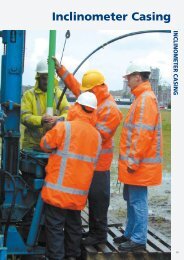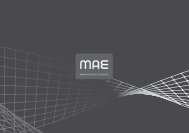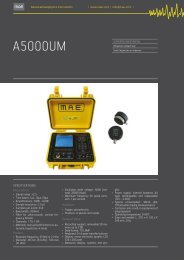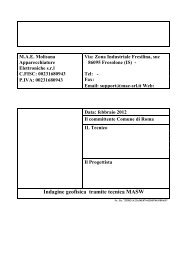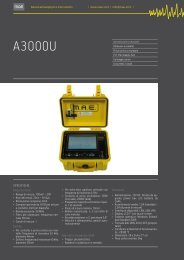Untitled
Untitled
Untitled
You also want an ePaper? Increase the reach of your titles
YUMPU automatically turns print PDFs into web optimized ePapers that Google loves.
› Mae 13<br />
Instrumentation for the execution of<br />
non-invasive surveys of sonic and ultrasonic<br />
type with an electro-mechanical<br />
hammer operating on concrete structures,<br />
masonry and on various types<br />
of building materials on site and in the<br />
laboratory. The extensive spectrum of<br />
incoming frequencies analysed, allows<br />
to take measurements on materials<br />
with different mechanical, compactness<br />
and homogeneity characteristics.<br />
The ultrasonic test through transparency<br />
is a standardized system in the<br />
diagnostics sector of concrete structures.<br />
From the analysis of the compression<br />
waves P in the material, it<br />
is possible to obtain the transit time<br />
(airborne time T.O.F.) of the ultrasonic<br />
waves in the material and the transmission<br />
speed of the same waves inside<br />
the material tested. The use of<br />
this method at high frequencies is<br />
particularly suitable for compact materials,<br />
as hardened concrete and on<br />
structural elements such as trusses,<br />
partition walls, or other types of<br />
concrete structures or stony materials<br />
with good aggregation degree.<br />
The sonic surveys are carried out using<br />
an electro-mechanical hammer<br />
that acts as trigger and a receiving<br />
probe. Waves on the material to inspect<br />
are generated on the trigger<br />
hammer, which are then detected by<br />
the receiving probe and recorded in<br />
the central unit. The sonic method is<br />
extensively used in tests of materials<br />
with scarce propagation characteristics,<br />
non-compact and heterogeneous<br />
materials in which the distances to<br />
travel are fairly high and they cannot<br />
be reached with the ultra-sonic system<br />
at other frequencies. A5000UM<br />
allows to assess the mechanical characteristics<br />
of the materials, evaluate<br />
the degree of homogeneity and possible<br />
presence of holes, gaps, defects<br />
or building anomalies of the element.<br />
Masonry structures, brick-faced walls,<br />
historic and monumental buildings<br />
can be assessed in terms of conservation<br />
state, in a quick and easy manner,<br />
limiting as much as possible the execution<br />
of destructive tests. Thanks to<br />
the presence of a large graphic display,<br />
the visualization and interpretation of<br />
the ultra-sonic waves generated is<br />
easy and immediate, the first reading<br />
can be picked and the speed and quality<br />
values of the material tested can<br />
be read directly on the device display.<br />
Each single wave emitted by the internal<br />
generator is visualized in full and<br />
it is also possible to modify the visualization<br />
parameters to further facilitate<br />
the reading of the crossing speed.<br />
The data is saved on a removable S.D.<br />
memory.<br />
mae-srl.it/go/A5000UM



